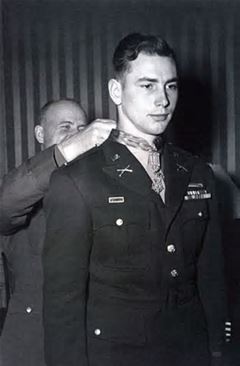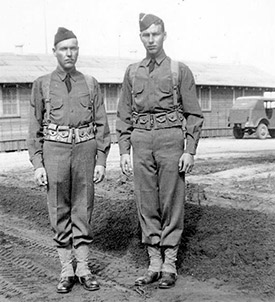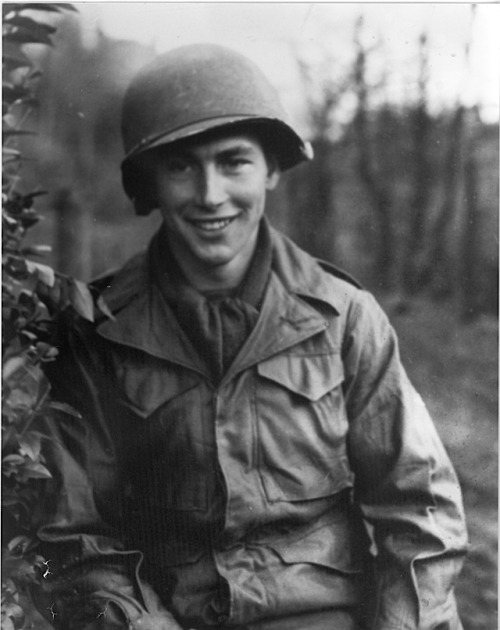Walter Ehlers
by William Bjornstad
Walter Ehlers received the highest military honor for his actions shortly after the Allied Normandy invasion on D-Day, June 6, 1944 and was the last survivor of the 12 US Army soldiers who received the medal for combat in the Normandy campaign (9 were awarded posthumously).
Growing up, he and his brother Roland worked on their uncle's Kansas farm. They joined the Army together in November 1940 and fought side by side in the North Africa and Sicily campaigns.
In the spring of 1944, they trained in England with the 18th Regiment, First Infantry Division, for the long-awaited Allied invasion of northern France. Both were assigned to Company K, its men destined to be in the second wave hitting Omaha Beach. Prior to the invasion, he was transferred to Company L, promoted to the rank of sergeant, and designated a squad leader so he and his brother would not have to fight alongside of each other again.
In July 1944 he learned that his brother had been killed on D-Day by a mortar shell that struck the ramp of his landing craft just as he stepped out to come ashore. Walter received the Medal of Honor on December 11, 1944, promoted to the rank of 2nd lieutenant, and served in the European Theater until the end of the war. In addition to the Medal of Honor, he also received the Silver Star, the Bronze Star, the Purple Heart with 2 oak leaf clusters, the World War II Victory Medal, and other military medals.
His Medal of Honor citation reads: " For conspicuous gallantry and intrepidity at the risk of his life above and beyond the call of duty on 9-10 June 1944, near Goville, France. S/Sgt. Ehlers, always acting as the spearhead of the attack, repeatedly led his men against heavily defended enemy strong points exposing himself to deadly hostile fire whenever the situation required heroic and courageous leadership. Without waiting for an order, S/Sgt. Ehlers, far ahead of his men, led his squad against a strongly defended enemy strong point, personally killing 4 of an enemy patrol who attacked him en route. Then crawling forward under withering machine gun fire, he pounced upon the guncrew and put it out of action. Turning his attention to 2 mortars protected by the crossfire of 2 machine guns, S/Sgt. Ehlers led his men through this hail of bullets to kill or put to flight the enemy of the mortar section, killing 3 men himself.
After mopping up the mortar positions, he again advanced on a machine gun, his progress effectively covered by his squad. When he was almost on top of the gun he leaped to his feet and, although greatly outnumbered, he knocked out the position single-handed. The next day, having advanced deep into enemy territory, the platoon of which S/Sgt. Ehlers was a member, finding itself in an untenable position as the enemy brought increased mortar, machine gun, and small arms fire to bear on it, was ordered to withdraw. S/Sgt. Ehlers, after his squad had covered the withdrawal of the remainder of the platoon, stood up and by continuous fire at the semicircle of enemy placements, diverted the bulk of the heavy hostile fire on himself, thus permitting the members of his own squad to withdraw. At this point, though wounded himself, he carried his wounded automatic rifleman to safety and then returned fearlessly over the shell-swept field to retrieve the automatic rifle which he was unable to carry previously. After having his wound treated, he refused to be evacuated, and returned to lead his squad. The intrepid leadership, indomitable courage, and fearless aggressiveness displayed by S/Sgt. Ehlers in the face of overwhelming enemy forces serve as an inspiration to others."
For years, Ehlers rarely talked about those accomplishments; not until word got around that it was his Medal of Honor heroics that were getting him invited to every presidential inauguration since Dwight D. Eisenhower's.
"He never bragged about it at all," his wife said of her husband's wartime heroics, adding he simply told people who commented on his Medal of Honor, "I wear it for all those who didn't come home." That included his older brother, Roland.
"He would always tell you his brother, who was killed on D-Day, was his hero," she said.
After returning home to Kansas, he moved to California and worked as a counselor for the Veterans Administration and later as a security guard at Disneyland. In 1955 he appeared in the film "The Long Gray Line," that starred Tyrone Power.
Riley County MoH History of Award



